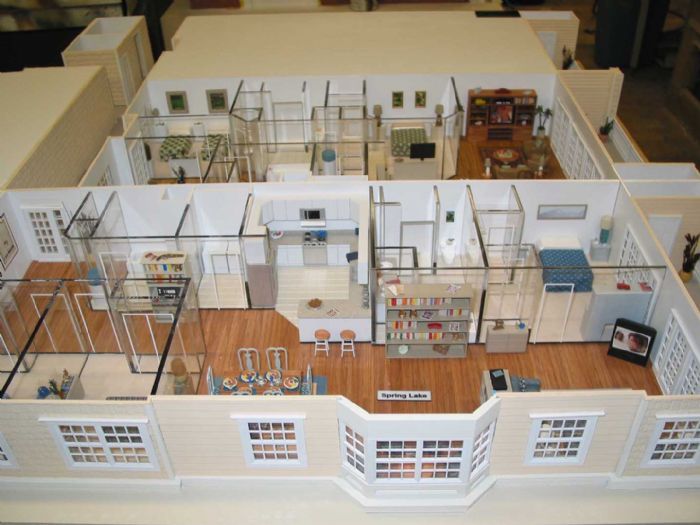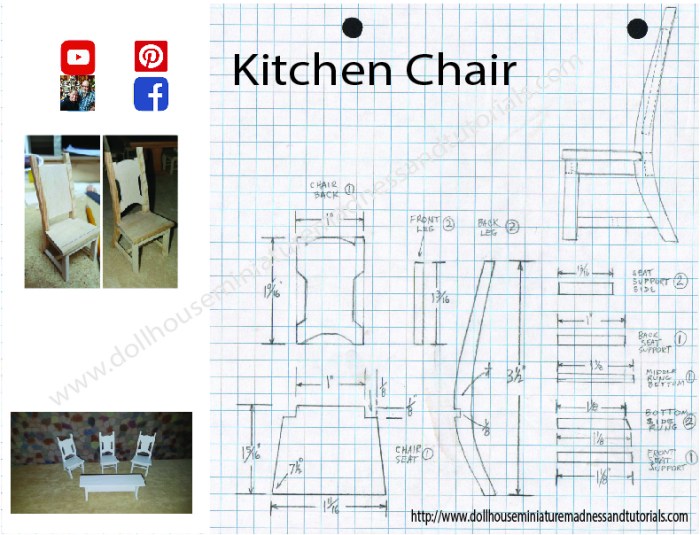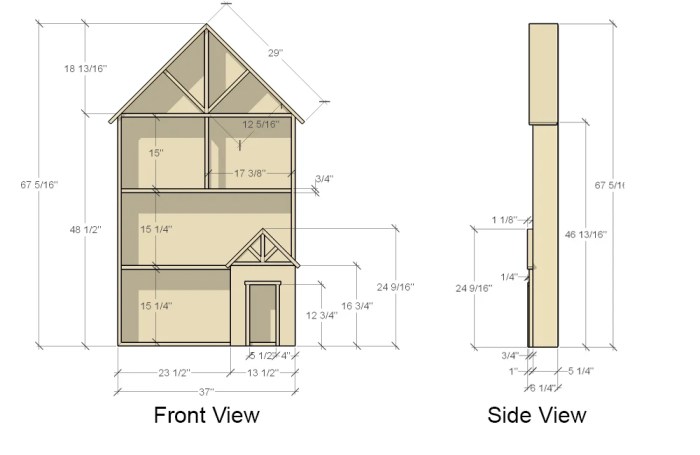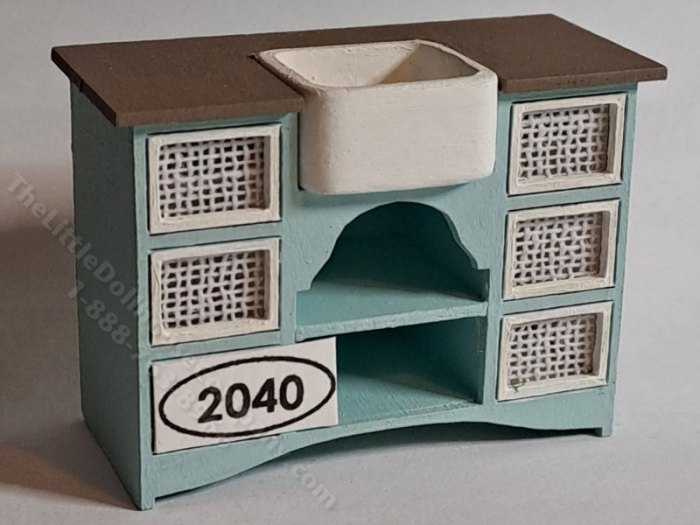Dollhouse furniture plans are your gateway to crafting miniature masterpieces for your dollhouse. These plans offer detailed blueprints and instructions, guiding you through the process of creating intricate furniture pieces that add life and charm to your miniature world. From classic Victorian styles to modern designs, there’s a plan for every taste and skill level. Whether you’re a seasoned crafter or a curious beginner, these plans provide the foundation for building beautiful and functional dollhouse furniture.
This guide delves into the world of dollhouse furniture plans, covering everything from finding the right plans to building and decorating your miniature creations. We’ll explore the different types of plans available, the essential materials and tools, and step-by-step instructions to help you create stunning miniature furniture for your dollhouse.
Materials and Tools for Building Dollhouse Furniture

Building dollhouse furniture is a rewarding hobby that allows you to create miniature versions of real-life furniture. The right materials and tools are crucial for creating durable and aesthetically pleasing pieces. This section explores the common materials and essential tools needed for building dollhouse furniture.
Materials for Dollhouse Furniture
The choice of materials depends on the specific design, desired outcome, and skill level. Here’s a list of common materials used for dollhouse furniture:
- Wood: Wood is a popular choice for dollhouse furniture due to its durability, versatility, and ease of working with. Balsa wood, basswood, and plywood are common choices for dollhouse furniture. Balsa wood is lightweight and easy to carve, while basswood is stronger and more durable. Plywood is a good option for creating sturdy furniture pieces.
- Cardboard: Cardboard is an affordable and readily available material for creating dollhouse furniture. It’s lightweight, easy to cut, and can be shaped into various forms. Thick cardboard, such as corrugated cardboard, is more durable and suitable for structural elements.
- Foam Board: Foam board is a lightweight and rigid material that can be used for creating walls, floors, and furniture pieces. It’s easy to cut and shape and can be painted or covered with fabric. Foam board is also a good option for creating intricate details and moldings.
- Fabric: Fabric can be used for upholstering furniture, creating curtains, and adding decorative elements. Felt, cotton, and velvet are common choices for dollhouse furniture. Fabric can be glued, stapled, or sewn onto furniture pieces.
- Paint: Paint is essential for adding color and detail to dollhouse furniture. Acrylic paints are a good choice for dollhouse furniture because they dry quickly, are water-based, and come in a wide range of colors. You can also use spray paint for a more even finish.
- Other Materials: Other materials used for building dollhouse furniture include wire, plastic, clay, and paper. Wire can be used for creating legs, handles, and other details. Plastic can be used for creating windows, doors, and other small details. Clay can be used for sculpting furniture pieces or creating decorative elements. Paper can be used for creating wallpaper, fabric patterns, and other decorative elements.
Tools for Building Dollhouse Furniture
Having the right tools makes the process of building dollhouse furniture easier and more efficient. Here’s a list of essential tools and their functions:
| Tool | Function |
|---|---|
| Scissors | Cutting paper, fabric, and cardboard |
| Craft Knife | Cutting wood, foam board, and other materials with precision |
| Saw | Cutting wood and other materials into specific shapes |
| Drill | Drilling holes for screws, hinges, and other fasteners |
| Glue | Adhering materials together |
| Sandpaper | Smoothing surfaces and removing rough edges |
| Paintbrushes | Applying paint to furniture pieces |
| Measuring Tape | Measuring and marking materials |
| Ruler | Drawing straight lines and measuring small distances |
| Pencil | Marking materials and transferring designs |
| Clamps | Holding materials together while gluing or drying |
| Screwdriver | Fastening screws and other hardware |
Choosing the Right Materials and Tools
The choice of materials and tools depends on the specific plan and desired outcome.
For example, if you’re building a simple chair out of cardboard, you’ll need scissors, a craft knife, glue, and paint. If you’re building a more intricate piece of furniture out of wood, you’ll need a saw, drill, sandpaper, and other woodworking tools.
Choosing the right materials and tools ensures that you can create durable and aesthetically pleasing dollhouse furniture.
Building Dollhouse Furniture from Plans: Dollhouse Furniture Plans
Building dollhouse furniture from plans is a rewarding experience that allows you to create unique and custom pieces for your miniature world. Following the plans step-by-step is essential for achieving accurate measurements, smooth edges, and a professional finish. This guide will walk you through the process of building dollhouse furniture from plans, providing tips and techniques to ensure success.
Cutting the Wood
Before starting, ensure you have all the necessary tools and materials. These include a ruler, pencil, saw, sandpaper, wood glue, clamps, and paint or stain. The first step is cutting the wood according to the plan’s measurements. This requires precision, as even a small error can affect the overall fit and appearance of the furniture.
- Use a sharp saw for clean cuts, and a miter saw for precise angles.
- Mark the wood with a pencil, ensuring the lines are clear and accurate.
- Measure twice, cut once, to avoid mistakes.
- Use a cutting guide or jig to ensure straight cuts.
Assembling the Furniture
Once all the pieces are cut, you can start assembling the furniture. This involves joining the pieces together using wood glue and clamps. It’s crucial to follow the plans carefully, ensuring each piece is in the correct position and securely fastened.
- Apply wood glue to the joint surfaces, ensuring an even coat.
- Use clamps to hold the pieces together while the glue dries.
- Allow the glue to dry completely before removing the clamps.
- Check for any gaps or misalignments and adjust as needed.
Finishing the Furniture
After assembly, you can finish the furniture to give it a polished look. This may involve sanding, painting, or staining.
- Sand the furniture with fine-grit sandpaper to smooth out any rough edges and prepare the surface for painting or staining.
- Apply paint or stain evenly, using multiple thin coats for a smooth finish.
- Allow the paint or stain to dry completely before handling the furniture.
Tips for Accuracy and Smooth Edges
To achieve accurate measurements and smooth edges, consider the following tips:
- Use a sharp pencil for marking the wood.
- Use a ruler or measuring tape to ensure precise measurements.
- Use a cutting guide or jig to ensure straight cuts.
- Sand the wood with fine-grit sandpaper to remove any rough edges.
- Use clamps to hold the pieces together while the glue dries.
- Apply paint or stain evenly, using multiple thin coats for a smooth finish.
Achieving a Professional Finish, Dollhouse furniture plans
A professional finish is achieved through meticulous attention to detail and careful execution. Here are some tips to elevate your dollhouse furniture:
- Use high-quality wood and materials.
- Cut the wood precisely and accurately.
- Sand the wood smooth and prepare it for painting or staining.
- Apply paint or stain evenly and carefully.
- Use a clear sealant to protect the finish.
Decorating and Furnishing Dollhouses

Now that you’ve built some amazing dollhouse furniture, it’s time to make your miniature world come to life! Decorating and furnishing a dollhouse is a fun and creative process where you can express your personal style and create a truly unique space.
Decorating Styles and Themes
Dollhouse decorating styles mirror real-life design trends, allowing you to recreate your favorite aesthetics in miniature. From classic Victorian to modern minimalist, you can find inspiration everywhere.
- Victorian: This style is known for its ornate details, rich colors, and luxurious fabrics. Think plush velvet furniture, intricate wallpaper patterns, and delicate lace curtains.
- Modern: Clean lines, simple shapes, and a neutral color palette define modern dollhouse decor. Use sleek furniture, minimalist artwork, and pops of color in accessories.
- Farmhouse: Rustic charm and a touch of vintage are key to the farmhouse style. Think distressed wood furniture, floral patterns, and cozy accents like woven baskets and antique lamps.
- Cottagecore: Embrace the whimsical and romantic aspects of cottage life with soft pastels, floral prints, and natural materials. Use vintage-inspired furniture, delicate china, and blooming flower arrangements.
Examples of Dollhouse Furniture Plans

There are many resources available online and in print that offer dollhouse furniture plans. These plans can range from simple to complex, and they can be tailored to suit any skill level.
Free Dollhouse Furniture Plans
Many websites offer free dollhouse furniture plans. These plans are a great way to get started with dollhouse furniture building, as they allow you to try out different designs without having to invest in expensive plans.
-
Type of Furniture: Various furniture pieces (e.g., bed, table, chair)
Scale: 1:12
Complexity: Easy to intermediate
Source: Instructables -
Type of Furniture: Victorian dollhouse furniture
Scale: 1:12
Complexity: Intermediate to advanced
Source: Pinterest -
Type of Furniture: Modern dollhouse furniture
Scale: 1:12
Complexity: Easy to intermediate
Source: Etsy
Paid Dollhouse Furniture Plans
If you’re looking for more detailed plans or a wider variety of designs, you can purchase dollhouse furniture plans from a number of online retailers and publishers.
-
Type of Furniture: Detailed dollhouse furniture plans for various styles and periods
Scale: 1:12
Complexity: Intermediate to advanced
Source: Amazon -
Type of Furniture: Specialized dollhouse furniture plans (e.g., miniature kitchens, bathrooms, and bedrooms)
Scale: 1:12
Complexity: Intermediate to advanced
Source: Dollhouse Plans -
Type of Furniture: Various dollhouse furniture plans with detailed instructions
Scale: 1:12
Complexity: Beginner to advanced
Source: Dollhouse Mania
Tips for Beginners

Building dollhouse furniture can be a rewarding and enjoyable hobby, but it can also seem daunting for beginners. Don’t worry! This section provides tips to help you get started and build confidence as you create miniature masterpieces.
Start with Simple Plans
Starting with simple plans is crucial for beginners. Simple plans typically involve fewer pieces, basic shapes, and straightforward construction techniques. This allows you to familiarize yourself with the process without feeling overwhelmed. Examples of simple projects include a basic table, a small chair, or a simple bed. As you gain experience and confidence, you can gradually progress to more complex designs.
Practice and Experiment
Practice makes perfect! Building dollhouse furniture involves developing hand-eye coordination, precision, and an understanding of woodworking techniques. Don’t be afraid to experiment with different materials, tools, and techniques. Each project provides an opportunity to learn and improve your skills. Even if a project doesn’t turn out perfectly, you’ll gain valuable experience and insights.
Use High-Quality Materials
Using high-quality materials is essential for creating durable and aesthetically pleasing dollhouse furniture. Investing in quality wood, glue, paint, and other supplies will ensure that your furniture lasts and looks its best. While it may seem tempting to use cheaper materials, they can lead to problems like warping, cracking, or uneven finishes.
Take Your Time
Rushing through the process can lead to mistakes. Take your time to carefully read the plans, measure accurately, and cut precisely. Don’t be afraid to ask for help or guidance from experienced builders if needed. Patience and attention to detail are key to creating beautiful and functional dollhouse furniture.
Enjoy the Process
Building dollhouse furniture should be an enjoyable experience. Don’t get discouraged if things don’t go perfectly the first time. Focus on the process of learning and creating, and appreciate the satisfaction of completing a project. As you gain experience, you’ll find that building dollhouse furniture becomes more enjoyable and rewarding.
Final Summary

With a little creativity and these detailed plans, you can transform your dollhouse into a miniature haven of beautifully crafted furniture. The process is rewarding, allowing you to unleash your imagination and create unique pieces that reflect your personal style. Whether you’re crafting a cozy living room or a whimsical bedroom, these plans empower you to build a miniature world that’s truly your own.
Questions Often Asked
What are the best materials for building dollhouse furniture?
Common materials include wood, cardboard, foam board, fabric, and even polymer clay. The choice depends on the project and your desired aesthetic.
How do I scale down measurements for dollhouse furniture?
Most plans use a scale, such as 1:12, meaning 1 inch on the plan equals 12 inches in real life. You’ll need to divide real-life measurements by the scale factor.
Where can I find free dollhouse furniture plans?
Many websites offer free plans, including online crafting communities, blogs, and even some dollhouse manufacturer websites.
Building dollhouse furniture can be a fun and rewarding project. You can find all sorts of plans online, but if you’re looking for something a little more advanced, you might want to check out master woodworking plans. These plans often cover more complex techniques and designs, which can be helpful if you want to create truly unique and intricate dollhouse furniture.
